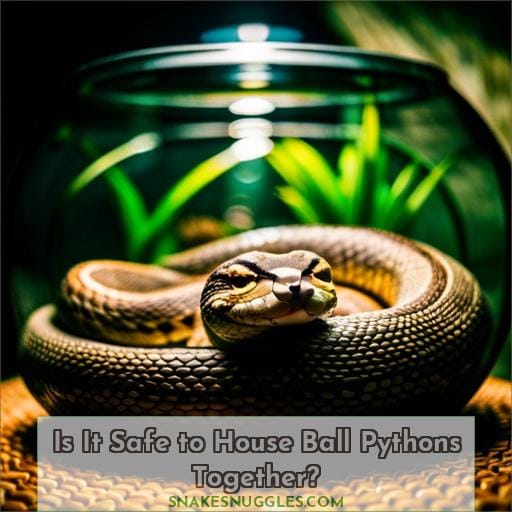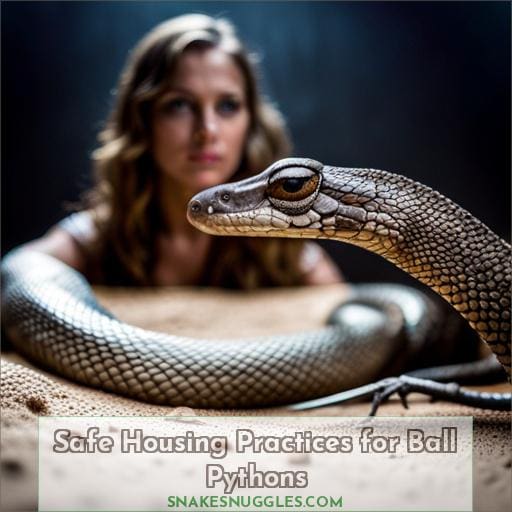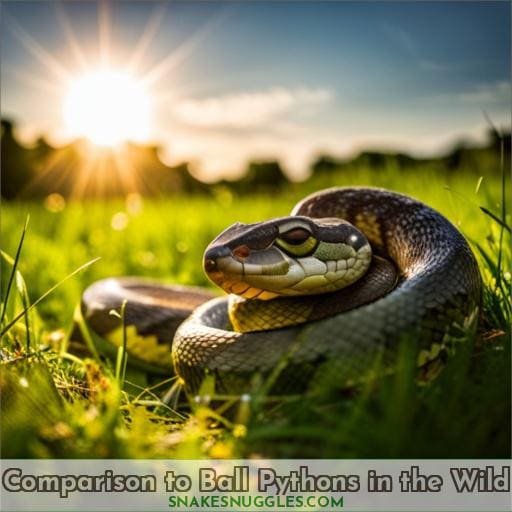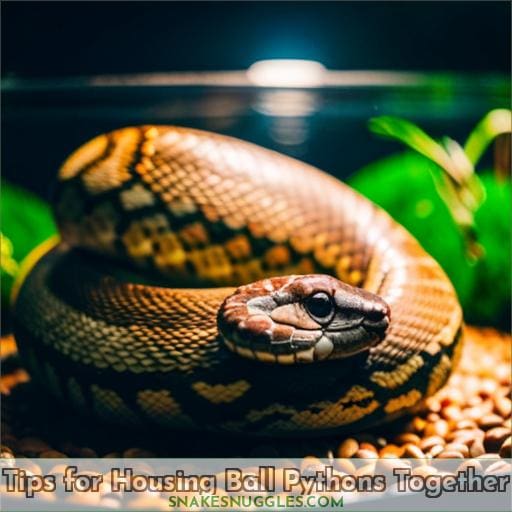This site is supported by our readers. We may earn a commission, at no cost to you, if you purchase through links.
 If you’ve ever seen two ball pythons coiled together, it’s easy to understand why many pet owners would consider housing multiple snakes in the same enclosure.
If you’ve ever seen two ball pythons coiled together, it’s easy to understand why many pet owners would consider housing multiple snakes in the same enclosure.
Ball pythons are naturally solitary animals and prefer their own space. Keeping them together increases the risk of disease, competition for food, dominance issues, and even cannibalism!
In this article, we’ll discuss whether or not it is safe to house two ball pythons together – complete with facts on how they behave in nature as well as some safety tips when considering a multi-snake setup.
Table Of Contents
- Key Takeaways
- Is It Safe to House Ball Pythons Together?
- Risks of Housing Two Ball Pythons Together
- Safe Housing Practices for Ball Pythons
- Comparison to Ball Pythons in the Wild
- Tips for Housing Ball Pythons Together
- Frequently Asked Questions (FAQs)
- Is it possible to house multiple ball pythons of different sexes together?
- How often should I clean the enclosure when housing multiple pythons together?
- What precautions should I take when introducing two ball pythons to the same tank?
- How can I tell if my ball pythons are displaying signs of stress?
- Are there any other species that can be housed together with ball pythons?
- Conclusion
Key Takeaways
- Ball pythons prefer solitary living.
- Cohousing can lead to disease spread, food competition, aggression, and cannibalism.
- Proper enclosure conditions, enrichment, health monitoring, and stress management are essential.
- Compatibility with other snake species should be researched, and the effort and expenses of cohousing should be considered.
Is It Safe to House Ball Pythons Together?
You must carefully consider the risks and dangers before deciding whether to bring two ball pythons home, as it can have a negative impact on their well-being. Dominance struggles may arise during mating season or resource competition, with weaker snakes getting hurt in the process.
Cannibalism is a risk when there are size differences or mixed ages amongst them.
Additionally, cohabitation of male and female ball pythons increases aggression levels, which can lead to harm for either snake as well as egg binding in females kept together with males. Illnesses spread quickly among snakes sharing an enclosure, so proper sanitation is essential if attempting housing more than one python at once.
This also requires more effort when feeding due to potential food stealing from dominant members of the group, leading to malnutrition and poor health for submissive ones who might starve themselves out of fear or stress caused by lack of space within their tank environment.
Even though larger enclosures are recommended along with separate territories that need enrichment elements like branches and greenery, while being maintained regularly costing extra time and money too! While possible, it’s best not to attempt such living arrangements since they contradict snakes’ solitary nature.
Risks of Housing Two Ball Pythons Together
When considering the risks of housing two ball pythons together, it is important to note that they are solitary animals by nature and prefer living alone. Common issues include dominance and aggression between snakes, competition for food leading to malnutrition or anorexia, as well as increased chances of stress-related behavioral problems such as egg binding in females kept with males and even cannibalism when there is a size difference or mixed ages involved.
Dominance and Aggression
When two ball pythons share a tank, the potential for dominance struggles and aggression is frighteningly high. Social hierarchies, environmental needs, and stress levels must all be considered when housing multiple pythons together.
Temporary housing is necessary for breeding habits. Providing multiple heat sources can help reduce territorial behavior. It is important to ensure a clear dominance hierarchy between male and female pythons.
Stress-related illnesses can occur due to overcrowding of tanks or inadequate resources. To prevent health issues or injuries caused by fighting, it is important to separate snakes into different enclosures if more than one snake is kept in the same environment.
Taking these precautions will help ensure that your pet remains healthy and safe in their home environment without unnecessary risks posed by cohabitation of two ball pythons.
Competition for Food
Competition for food can occur if two ball pythons are housed together, potentially resulting in malnutrition and poor health. Food scarcity is likely when there is an age difference or different dietary needs.
To prevent harm, provide multiple basking spots to reduce stress levels and ensure enough space for each snake’s requirements.
Competition for resources should be avoided as it increases stress in snakes that may already feel threatened by the presence of another individual. Housing ball pythons together requires careful consideration of all risks involved; failure to do so could result in serious consequences on their overall well-being.
| Positive Impact | Negative Impact | Neutral |
|---|---|---|
| Diversity & Variety | Aggression | Stress |
| Enrichment Elements | Cannibalism | Resource Competition |
Stress and Behavioral Issues
Stress and behavioral issues can arise when two ball pythons are thrown together, like oil and water. To ensure pet safety, environmental complexity must be considered to minimize stress levels.
Dominance hierarchies tend to form in single species enclosures with a social hierarchy that may lead to aggressive behavior between snakes. Disease transmission is another serious risk due to the lack of sanitation measures taken by cohabitating snakes.
Proper snake health requires strict monitoring as well as regular check-ups for parasite infestation or any other reptile diseases they could contract from each other.
Optimizing their housing environment for increased complexity can help them adjust better but ultimately it’s best not to house more than one ball python per tank unless necessary circumstances require it – then mitigation efforts should be taken seriously.
Risk of Cannibalism
Cannibalism is a real risk when two ball pythons are cohabiting, so it’s important to be aware of the potential dangers. Quality and size of enclosure, as well as mating behavior, should all be considered.
Health concerns can arise due to increased stress and weakened immunity caused by competition for resources or dominance from one snake over the other. Furthermore, legal implications may exist if male and female ball pythons are housed together without consideration for their solitary nature.
Sharing a tank with another python puts both animals at risk of cannibalism; therefore, care must be taken in providing separate territories within an appropriately sized enclosure in order to reduce this danger.
Increased Chances of Illness
When two ball pythons are forced to share an enclosure, their chances of contracting illnesses significantly increase. Illness transmission is a major risk when housing multiple snakes together due to the close proximity and lack of sanitation practices.
Even temporary mating between males and females can result in disease spread or stress-related health risks such as egg binding. Furthermore, cohabitation requires extra expenses for larger enclosures plus additional time for cleaning and maintenance – all on top of increased stress levels for both animals.
Safe ball python housing tips include separate territories with enrichment elements like branches or greenery, rigorous sanitation protocols, and proper feeding habits monitored daily. Though these precautions cannot guarantee complete protection from disease transmission or aggression issues that may arise within the tank’s inhabitants.
Safe Housing Practices for Ball Pythons
When it comes to housing two ball pythons together, it’s important to provide spacious enclosures with plenty of enrichment elements like branches and greenery. This will help reduce territorial behaviors among the snakes while also helping them feel more comfortable in their environment.
Additionally, maintaining a proper enclosure requires extra effort in terms of cleaning and expenses, as well as ensuring adequate health requirements are met for both animals.
Providing Spacious Enclosures
Providing a spacious and enriched enclosure is key for the well-being of your pet ball pythons, creating an oasis that allows them to bask in peace. You’ll need to invest extra effort into maintaining separate territories, proper sanitation practices, and feed monitoring with multiple snakes.
It’s important to research snake species compatibility before housing two different types together, as not all reptiles are suitable roommates. Size matters too; a larger terrarium setup will give each python enough space for eating, sleeping, or exploring without conflict or stress while keeping their habitat safe from disease spread.
Ball Python care requires dedication, but it can be incredibly rewarding when done correctly! Properly setting up a reptile habitat takes time but pays off in the long run – giving you assurance that your pets have exactly what they need for health and happiness.
Enrichment and Territorial Behaviors
Adding enrichment elements such as branches and greenery to the tank can help reduce territorial behaviors, leading to a safer cohabitation for your pet snakes. Social hierarchy is established in ball pythons through temperature differences, territorial marking, and enclosure modifications.
Females are more aggressive than males when sharing an enclosure, so it’s important to provide enough space for each snake. Understanding their ideal habitat helps ensure they’re able to establish territory, which reduces stress levels caused by living with another snake in close quarters.
Ball pythons are antisocial creatures that prefer solitary behavior over cohabitation; therefore, having a larger area allows them room away from one another while still providing companionship at times if desired or necessary due to mating needs, etc.
Enclosure size should be taken into consideration before attempting group housing of these animals as this will minimize risks associated with aggression and health concerns like disease transmission or cannibalism – resulting in happier, healthier pet snakes!
Maintenance and Cleaning
Caring for multiple ball pythons can be a challenge, so regular maintenance and cleaning are essential. Consideration should be given to the cost of supplies, space requirements, and temperature control.
Snake health depends on captivity conditions that mimic their natural environment; experts suggest separate tanks over co-housing due to solitary behavior. Cleaning helps prevent spreading disease, and maintaining proper humidity levels is important for female ball pythons when breeding season arrives! With extra effort required in such an endeavor, it may not offer enough benefit compared with keeping them apart – ultimately offering a safer solution for your pet snakes’ well-being.
Comparison to Ball Pythons in the Wild
In the wild, ball pythons are solitary animals and are rarely found in groups. Although they may benefit from living together temporarily when mating, there can be risks associated with sharing an enclosure, such as dominance struggles, resource competition, and the spread of disease.
It is important to consider these potential issues before deciding if co-housing ball pythons is a good idea for your pet snakes.
Natural Behavior of Ball Pythons
Understanding ball pythons and their solitary habits is key to providing proper care. In nature, they live alone outside of mating season or in cramped spaces. To thrive, these animals need a habitat that meets their environmental needs and keeps stress levels low.
It’s important to remember they are not meant for cohabitation. Therefore, it is best practice to avoid housing multiple ball pythons together, as risks such as dominance struggles can occur, which may lead to harm and stress on your pet snake(s).
Risks and Dangers in the Wild
When considering housing ball pythons together, it’s important to understand the risks and dangers that can arise in their natural habitat.
For example, two males competing for a mate or resources may fight aggressively, risking injury to both snakes. Other factors, such as mating rituals, temperature control, stress reduction, and breeding opportunities, should all be taken into consideration when deciding if multiple ball pythons are suitable for one enclosure.
Additionally, diet variation must be accounted for. Different age groups require varied diets, which could lead to competition among the group of snakes in an enclosed space.
Ultimately, these potential issues mean that separate territories with proper sanitation would need to be provided to ensure cohabitation works out safely long-term. This makes research and consideration essential prior to any decision being made on housing multiple ball pythons together.
Tips for Housing Ball Pythons Together
When it comes to housing ball pythons together, compatibility with other snake species, size and type of enclosure, as well as feeding and health monitoring are all important considerations.
It is possible for some non-ball python snakes, such as garter or female corn snakes, to cohabit with them in the same tank. However, this should only be done if the right-sized environment is provided that allows each snake enough space for basking areas and enrichment elements like branches.
Additionally, extra effort should be put into feeding schedules to ensure both animals receive adequate nutrition without competition over food sources.
Compatibility With Other Snake Species
Although ball pythons prefer to live alone, some other species of snakes may be compatible for cohabitation. Breeding two different snake species can result in genetic and health issues, so it’s important to research the age gap and socialization levels between them before mixing.
Species known to coexist are garter snakes or certain female corn snakes. Competition for food is also a factor. If one outgrows the other too quickly, malnutrition could occur due to unequal access or resources stolen from the less dominant snake.
In short, safe housing involves researching compatibility prior to mixing species, as well as providing ample space with enrichment elements like basking areas and branches.
Size and Type of Enclosure
Choosing the right size and type of enclosure when housing ball pythons together is essential for their well-being. For example, a pair of male ball pythons living in too small an enclosure may lead to stress and aggression between them.
Larger enclosures with separate territories are recommended to reduce competition. Proper sanitation will help prevent disease spread. Extra time should be taken to monitor health, as wild behaviors can occur if snakes feel threatened or stressed.
Regularly checking stools for parasites is also advised, along with providing enrichment items like branches or greenery. This encourages natural behavior without territorial issues arising. Health monitoring must remain constant due to potential risks associated with cohabitation, such as malnutrition, infections, or cannibalism.
Therefore, it’s important that snake owners take all necessary steps before attempting this method of housing multiple snakes together.
Feeding and Health Monitoring
Feeding your pet ball pythons and monitoring their health is essential when cohabiting multiple snakes. Temperature control, nutrition guidelines, and stress levels should all be taken into account to reduce competition for resources and prevent the spread of disease.
An adequate enclosure size is needed to ensure enough space for each snake, while temperature gradients provide basking areas that accommodate different preferences in heat requirements. Stress can quickly lead to illness or death, so it’s important to monitor behavior closely.
The key is providing a safe environment with plenty of resources. This will decrease the chances of harm coming from overcrowding or fighting over food or territory.
Frequently Asked Questions (FAQs)
Is it possible to house multiple ball pythons of different sexes together?
It’s possible to house ball pythons of different sexes together, but it can be risky. Consider larger enclosures and separate territories for the snakes, adequate sanitation practices, and thorough research before attempting this.
Understand that there are risks such as dominance struggles, resource competition, and disease spread which could negatively affect the well-being of your pet snake(s).
How often should I clean the enclosure when housing multiple pythons together?
Cleaning the enclosure for multiple ball pythons should be done frequently. Sanitizing surfaces, removing waste, and replacing bedding help maintain their health and well-being. Monitor conditions regularly to ensure an optimal living environment – reduce stressors, prevent disease transmission, and address dominance issues arising from cramped spaces.
What precautions should I take when introducing two ball pythons to the same tank?
When introducing two ball pythons to the same tank, take precautionary measures – such as providing a spacious enclosure with multiple basking areas and enrichment elements. Ensure proper sanitation, separate territories for each snake, and closely monitor their health.
How can I tell if my ball pythons are displaying signs of stress?
Signs of stress in ball pythons include a loss of appetite, excessive activity, and aggressive behavior. Monitor their eating habits and observe any changes in behavior to ensure they are comfortable when sharing a tank.
Are there any other species that can be housed together with ball pythons?
You may be able to house garter snakes and certain female corn snakes with your ball python. Be mindful of the risks, however, as introducing a second species could negatively impact both animals’ well-being.
Consider researching more before deciding whether cohabitation is best for them.
Conclusion
Overall, housing two ball pythons together can be a tricky endeavor. As solitary creatures, ball pythons in the wild live separately from one another for the most part. When attempting to keep two together, it’s important to consider the risks of aggression, competition for food, cannibalism, and disease spread.
To keep your pet ball pythons safe and healthy, it’s essential to provide them with a spacious enclosure, plenty of enrichment, and regular maintenance. Like any other decision, it’s important to do your research and weigh the pros and cons before diving in head-first.
As the saying goes, look before you leap. If you decide to house two pythons together, make sure you’re taking all the necessary precautions.











